Getting Started with NHibernate and ASP.NET MVC- CRUD Operations
来源:互联网 发布:c语言代码翻译成中文 编辑:程序博客网 时间:2024/05/21 21:43
转自:http://www.dotnetjalps.com/2013/09/asp-net-mvc-nhibernate-crud-getting-started.html
In this post we are going to learn how we can use NHibernate in ASP.NET MVC application.
What is NHibernate:

ORMs(Object Relational Mapper) are quite popular this days. ORM is a mechanism to map database entities to Class entity objects without writing a code for fetching data and write some SQL queries. It automatically generates SQL Query for us and fetch data behalf on us.
NHibernate is also a kind of Object Relational Mapper which is a port of popular Java ORM Hibernate. It provides a framework for mapping an domain model classes to a traditional relational databases. Its give us freedom of writing repetitive ADO.NET code as this will be act as our database layer. Let’s get started with NHibernate.
How to download:
There are two ways you can download this ORM. From nuget package and from the source forge site.
- Nuget - http://www.nuget.org/packages/NHibernate/
- Source Forge-http://sourceforge.net/projects/nhibernate/
Creating a table for CRUD:
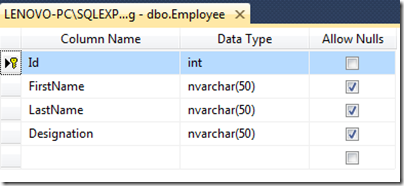
Creating ASP.NET MVC project for NHibernate:
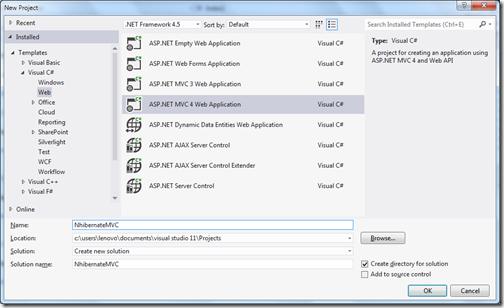
Installing NuGet package for NHibernate:
I have installed nuget package from Package Manager console via following Command.

It will install like following.

NHibertnate configuration file:
Nhibernate needs one configuration file for setting database connection and other details. You need to create a file with ‘hibernate.cfg.xml’ in model Nhibernate folder of your application with following details.
<?xmlversion="1.0"encoding="utf-8"?><hibernate-configurationxmlns="urn:nhibernate-configuration-2.2"> <session-factory> <propertyname="connection.provider"> NHibernate.Connection.DriverConnectionProvider </property> <propertyname="connection.driver_class"> NHibernate.Driver.SqlClientDriver </property> <propertyname="connection.connection_string"> Server=(local);database=LocalDatabase;Integrated Security=SSPI; </property> <propertyname="dialect"> NHibernate.Dialect.MsSql2012Dialect </property> </session-factory></hibernate-configuration>Here you have got different settings for NHibernate. You need to selected driver class, connection provider as per your database. If you are using other databases like Orcle or MySQL you will have different configuration. ThisNHibernate ORM can work with any databases.
Creating a model class for NHibernate:
Now it’s time to create model class for our CRUD operations. Following is a code for that. Property name is identical to database table columns.
namespaceNhibernateMVC.Models{ publicclass Employee { publicvirtual int Id { get;set; } publicvirtual string FirstName { get;set; } publicvirtual string LastName { get;set; } publicvirtual string Designation { get;set; } }}Creating a mapping file between class and table:
<?xmlversion="1.0"encoding="utf-8"?><hibernate-mappingxmlns="urn:nhibernate-mapping-2.2"auto-import="true"assembly="NhibernateMVC"namespace="NhibernateMVC.Models"> <classname="Employee"table="Employee"dynamic-update="true"> <cacheusage="read-write"/> <idname="Id"column="Id"type="int"> <generatorclass="native"/> </id> <propertyname="FirstName"/> <propertyname="LastName"/> <propertyname="Designation"/> </class></hibernate-mapping>Creating a class to open session for NHibernate:
I have created a class in models folder called NHIbernateSession and a static function it to open a session for NHibertnate.
usingSystem.Web;usingNHibernate;usingNHibernate.Cfg;namespaceNhibernateMVC.Models{ publicclass NHibertnateSession { publicstatic ISession OpenSession() { var configuration = newConfiguration(); var configurationPath = HttpContext.Current.Server.MapPath(@"~\Models\Nhibernate\hibernate.cfg.xml"); configuration.Configure(configurationPath); var employeeConfigurationFile = HttpContext.Current.Server.MapPath(@"~\Models\Nhibernate\Employee.hbm.xml"); configuration.AddFile(employeeConfigurationFile); ISessionFactory sessionFactory = configuration.BuildSessionFactory(); returnsessionFactory.OpenSession(); } }}Listing:
Now we have our open session method ready its time to write controller code to fetch data from the database. Following is a code for that.
usingSystem;usingSystem.Web.Mvc;usingNHibernate;usingNHibernate.Linq;usingSystem.Linq;usingNhibernateMVC.Models;namespaceNhibernateMVC.Controllers{ publicclass EmployeeController : Controller { publicActionResult Index() { using(ISession session = NHibertnateSession.OpenSession()) { var employees = session.Query<Employee>().ToList(); returnView(employees); } } }}Here you can see I have get a session via OpenSession method and then I have queried database for fetching employee database. Let’s create a new for this you can create this via right lick on view on above method.We are going to create a strongly typed view for this.
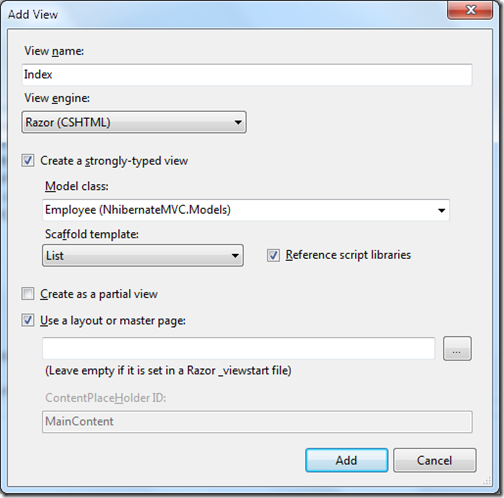
Our listing screen is ready once you run project it will fetch data as following.

Create/Add:
Now its time to write add employee code. Following is a code I have written for that. Here I have used session.save method to save new employee. First method is for returning a blank view and another method with HttpPost attribute will save the data into the database.
publicActionResult Create(){ returnView();} [HttpPost]publicActionResult Create(Employee emplolyee){ try { using(ISession session = NHibertnateSession.OpenSession()) { using(ITransaction transaction = session.BeginTransaction()) { session.Save(emplolyee); transaction.Commit(); } } returnRedirectToAction("Index"); } catch(Exception exception) { returnView(); }}Now let’s create a create view strongly typed view via right clicking on view and add view.
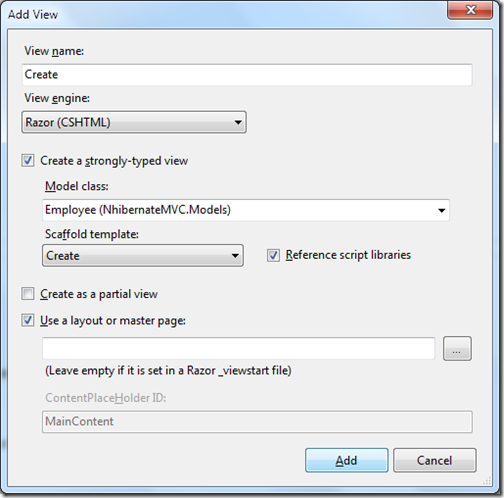
Once you run this application and click on create new it will load following screen.
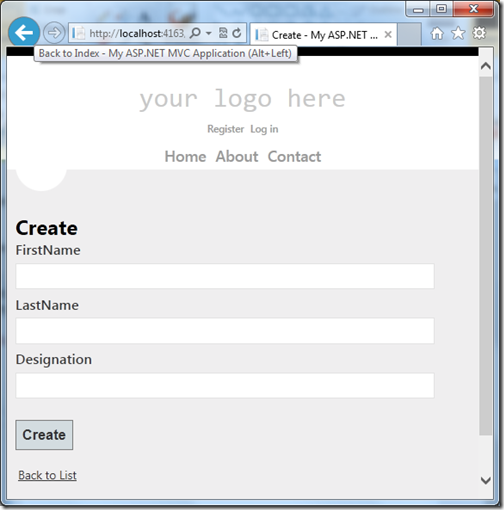
Edit/Update:
Now let’s create a edit functionality with NHibernate and ASP.NET MVC. For that I have written two action result method once for loading edit view and another for save data. Following is a code for that.
publicActionResult Edit(intid){ using(ISession session = NHibertnateSession.OpenSession()) { var employee = session.Get<Employee>(id); returnView(employee); } }[HttpPost]publicActionResult Edit(intid, Employee employee){ try { using(ISession session = NHibertnateSession.OpenSession()) { var employeetoUpdate = session.Get<Employee>(id); employeetoUpdate.Designation = employee.Designation; employeetoUpdate.FirstName = employee.FirstName; employeetoUpdate.LastName = employee.LastName; using(ITransaction transaction = session.BeginTransaction()) { session.Save(employeetoUpdate); transaction.Commit(); } } returnRedirectToAction("Index"); } catch { returnView(); }}Here in first action result I have fetched existing employee via get method of NHibernate session and in second I have fetched and changed the current employee with update details. You can create view for this via right click –>add view like below. I have created a strongly typed view for edit.
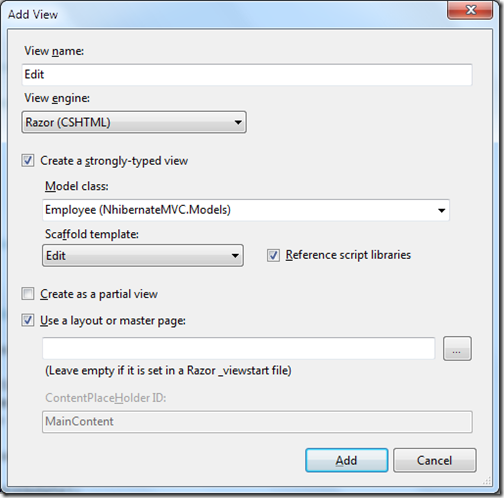
Once you run code it will look like following.

Details:
Now it’s time to create a detail view where user can see the employee detail. I have written following logic for details view.
publicActionResult Details(intid) { using(ISession session = NHibertnateSession.OpenSession()) { var employee = session.Get<Employee>(id); returnView(employee); } }You can add view like following via right click on actionresult view.
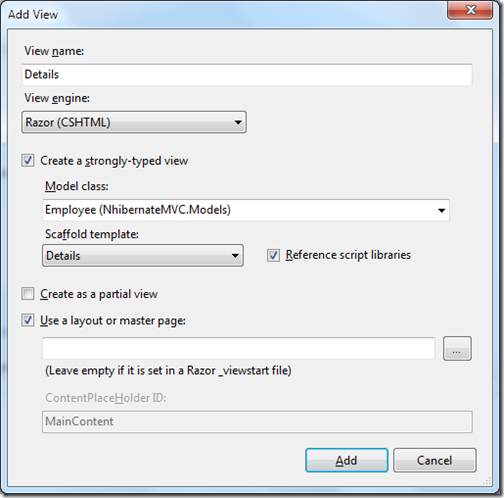
now once you run this in browser it will look like following.
Delete:
Now its time to write delete functionality code. Following code I have written for that.
publicActionResult Delete(intid){ using(ISession session = NHibertnateSession.OpenSession()) { var employee = session.Get<Employee>(id); returnView(employee); }} [HttpPost]publicActionResult Delete(intid, Employee employee){ try { using(ISession session = NHibertnateSession.OpenSession()) { using(ITransaction transaction = session.BeginTransaction()) { session.Delete(employee); transaction.Commit(); } } returnRedirectToAction("Index"); } catch(Exception exception) { returnView(); }}Here in the above first action result will have the delete confirmation view and another will perform actual delete operation with session delete method.
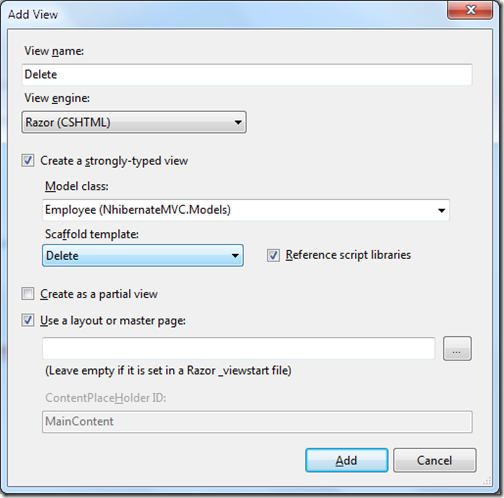
When you run into the browser it will look like following.
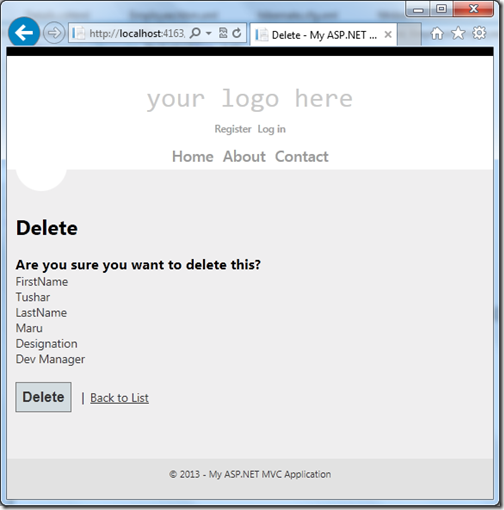
That’s it. It’s very easy to have crud operation with NHibernate. Stay tuned for more.
0 0
- Getting Started with NHibernate and ASP.NET MVC- CRUD Operations
- Getting Started with ASP.NET MVC
- Getting Started with ASP.NET MVC 5
- Getting Started with ASP.NET MVC 5
- asp.net mvc getting started with this framework
- FW: Getting Started with ASP.NET MVC 5
- ASP.NET WebAPI: Getting Started with MVC4 and WebAPI
- ASP.NET MVC 4 – CRUD operations Entity Framework (*.edmx)
- Getting Started with Java and Bluetooth (From www.java.net)
- Getting Started with Drools.NET
- Getting Started with Eclipse and the SWT
- Getting Started With Ruby and Rails
- Getting Started With Node.js and mongoDB
- Getting Started with Eclipse and Counterclockwise
- Getting Started with Kinect and Processing
- Getting Started With IronRuby And RSpec
- Getting started with OpenCL and GPU Computing
- Getting started with GWT, Maven and Eclipse
- 通过 File API 使用 JavaScript 读取文件
- 使用 Chrome 开发工具调试异步 JavaScript(Debugging Asynchronous JavaScript with Chrome DevTools)
- Linux下printf输出字符串的颜色
- criterial查询
- OpenStreetMap 获取地图数据
- Getting Started with NHibernate and ASP.NET MVC- CRUD Operations
- dede--新增文章
- UIImageView动画实现
- VC实现具有回车移动焦点功能的编辑框
- LeetCode 151. Reverse Words in a String
- linux下安装apache详解
- LeetCode刷题笔录Convert Sorted Array to Balanced Binary Search Tree
- timersession
- Literal pools(文字池)(ARM 汇编)


